and the distribution of digital products.
State of Polkadot Q3 2024
- Parity launched Agile Coretime, replacing the parachain leasing system with a new model, selling blockspace. This on-demand framework adjusts resource allocation to match network demand, reducing resource wastage during low activity and easing congestion at peak times.
- In Q3, Mythical Games launched on Polkadot and quickly rose to become one of the top three projects in the ecosystem by transaction volume. The platform recorded 11 million transactions, representing 15% of Polkadot's total transactions for the quarter, largely fueled by the success of NFL Rivals, a free-to-play mobile football game.
- Polkadot DAO treasury spend reduced by 53% in Q3 (from $60 million in Q2 to $28 million). Despite this reduction, OpenGov activity remained high, with referenda reaching an all-time high of 171 in July 2024, coinciding with the second highest month to date for the amount of DOT used to vote.
- Polkadot rollup extrinsics increased by 69% QoQ, reaching 763,000 daily transactions. The growth was largely led by the rollups like Frequency, Litentry, and Mythos, showcasing a broadening user base and ecosystem expansion.
- The active validator set increased to 400 in Q3 and is set to reach 500 in Q4. This expansion resulted in the Nakamoto Coefficient for Polkadot jumping to 112 in Q3.
Polkadot (DOT) is a distributed blockchain computing platform that acts as a base layer for other sovereign blockchains, referred to as rollups (formerly parachains), for validation and shared security. Polkadot was built using Substrate, a blockchain developmental framework. Furthermore, Polkadot’s base layer, the Polkadot Chain (aka Relay Chain), utilizes a Nominated Proof-of-Stake (NPoS) consensus mechanism, and its state machine is compiled to WebAssembly (Wasm).
The Polkadot Chain’s core function is to validate and provide security to its rollups. Agile Coretime, released during Q3 2024, enhances the network’s scalability, cost-efficiency, speed, and flexibility by dynamically allocating computational resources. This feature replaces the previous system of leasing single cores through auctions with an on-demand blockspace model, adjusting resource availability based on network demand. This approach helps prevent resource wastage during periods of low activity and mitigates congestion during peak times.
Lastly, Polkadot rollups can communicate with one another through the Cross-Consensus Mechanism Format (XCM). The XCM is a messaging format that standardizes messages between Polkadot’s rollups, allowing for greater interoperability.
Website / X (Twitter) / Discord
Key Metrics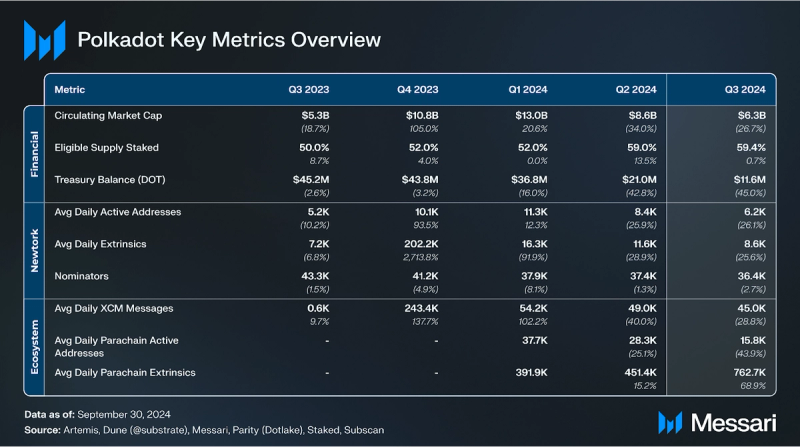 Ecosystem Analysis
Ecosystem Analysis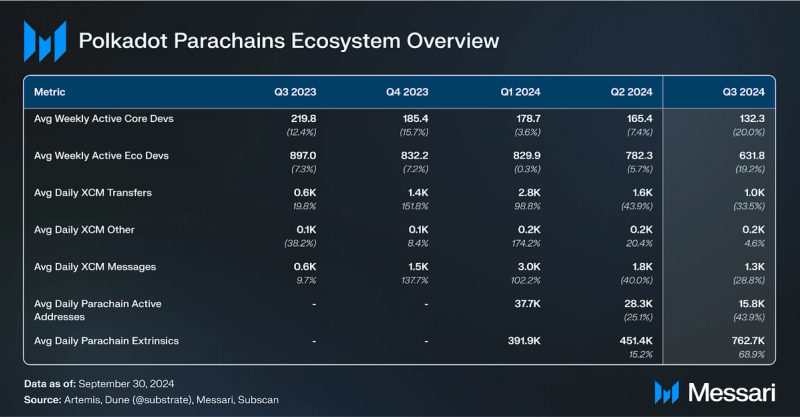 Development
Development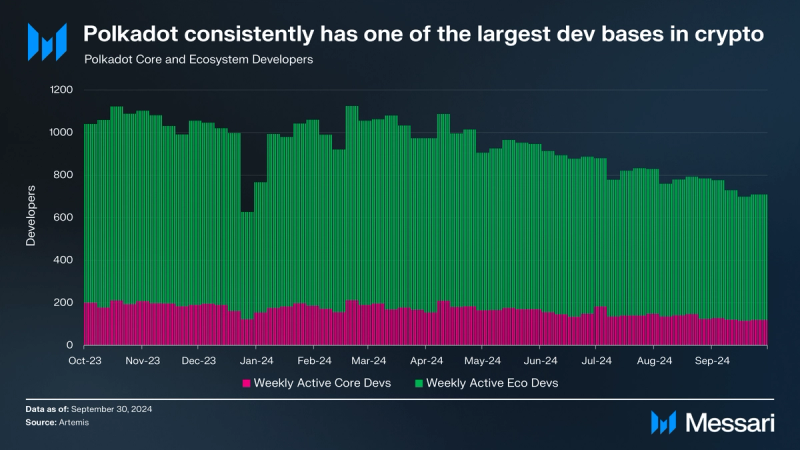
Polkadot boasts one of the largest developer bases in the crypto industry. According to Electric Capital, in July 2024, Polkadot had 2,400 monthly active developers, with 760 of them classified as full-time, placing the network fourth behind Ethereum, Base, and Polygon. Artemis also tracked developer data, reporting an average of 630 weekly active core developers and 760 weekly active ecosystem developers in Q3 2024.
In Q3 2024, Polkadot highlighted several key development initiatives. The Decentralized Futures program, supported by a $20 million fund and 5 million DOT tokens, continued to drive innovation within the ecosystem. The program provided grants to teams in marketing, business development, governance, and technology, supporting projects such as AirLyft, DotPlay, and BlockDeep Labs. Additionally, Gavin Wood introduced "Proof-of-Ink," a privacy-focused Web3 individuality solution that uses unique algorithmically generated tattoos verified through blockchain as proof of digital citizenship.
Polkadot’s 2024 Grants and Funding Guide, published in July, offered comprehensive details on funding opportunities across the ecosystem, focusing on areas like DeFi, gaming, and infrastructure. Lastly, Polkadot Decoded 2024 showcased Polkadot's vision for a decentralized future, featuring advancements in governance, technical innovations, and partnerships with companies such as Mythical Games and Ledger.
XCM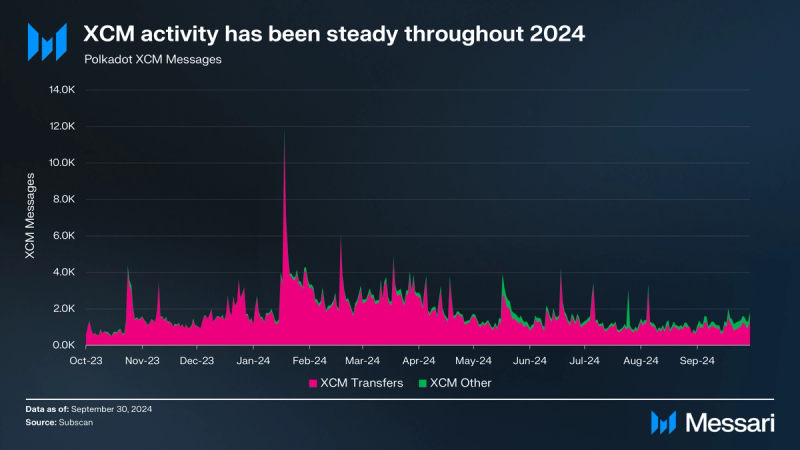
The Cross-Consensus Message Format (XCM) is a standardized messaging format and language that enables seamless communication between rollups and other consensus-driven systems. XCM plays a crucial role in facilitating interoperability and complex cross-consensus interactions. It allows blockchains to exchange messages, perform operations, and transfer assets, among other use cases.
In Q3 2024, Polkadot's XCM activity was mixed. Daily XCM transfers averaged 1,000 (-34% QoQ), while non-asset transfer use cases, termed "XCM Other," were at 200 daily (+5% QoQ). The total daily XCM messages averaged 1,300, reflecting a 29% decline QoQ.
Rollup Messages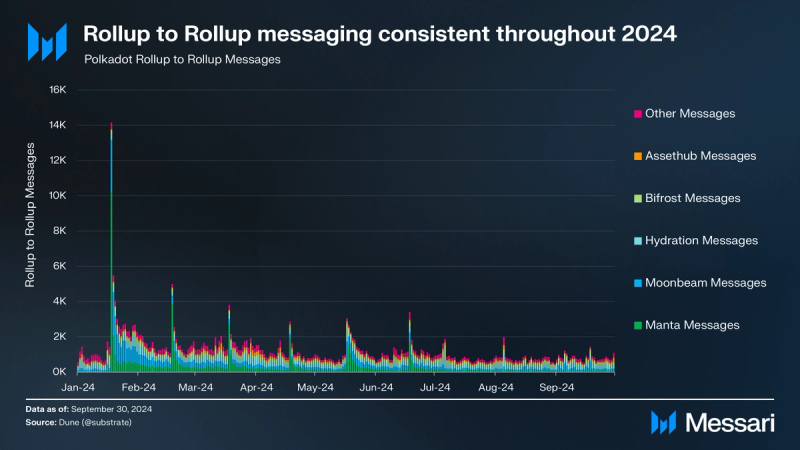
There are multiple ways in which messages are passed on the Polkadot Network: from rollups to the Polkadot Chain is upstream message passing, from the Polkadot Chain to rollups is downstream message passing, and from rollup to rollup is horizontal message passing. The above chart describes horizontal message passing.
In Q3 2024, Manta recorded 62 messages per day, Moonbeam had 141 per day, Hydration experienced 195 per day, Bifrost reported 175 per day, Assethub processed 70 per day, and other rollups collectively saw 154 messages per day. Notably, all leading Polkadot rollups by message activity saw declines, except for Hydration, which maintained its activity levels.
Mythos, which launched on Polkadot on July 31, 2024,p hosts a wildly popular game called NFL Rivals, a free-to-play mobile football game available on iOS and Android featuring arcade-style gameplay with official NFL licenses. Players build teams using digital card NFTs, which offer potential monetary value through a secondary marketplace. Users can buy or trade NFTs using Mythos tokens, blending traditional gaming with Web3 elements. Additionally, Pudgy Penguins, an Ethereum NFT brand, will debut a mobile game in 2025 on Mythos Chain. Since migrating from Ethereum to Polkadot, Mythos has issued, burned, or transferred over 16 million NFTs by time of writing.
During Q2 2024, Parity published several deep dives into different rollups verticals, including AI-focused rollups such as OriginTrail’s verifiable knowledge graph, Phala Network’s secure AI-Agent Contract, and Bittensor’s AI platform. They also highlighted the ongoing development of bridges, such as the BEEFY protocol, the Polkadot to Kusama bridge, and Snowbridge for trustless Ethereum bridging. Additionally, Parity discussed the development of Real World Asset rollups and protocols, including Centrifuge, Energy Web for green assets, and AgroToken for agricultural commodities.
Rollup Addresses
The majority of activity on the Polkadot Network occurs on Polkadot rollups. In Q3 2024, Polkadot rollup active addresses experienced a decline, with an average of 15,800 daily active addresses, reflecting a 44% decrease from the previous quarter.
All of the leading rollups by address activity remained the same in Q3 2024. Moonbeam maintained its lead with 3,200 daily active addresses. During Q3 2024, Moonbeam introduced plans for a strategic expansion into the Ethereum ecosystem. This initiative aims to launch an expansion chain in the re-staking ecosystem that leverages Ethereum validators and restaking for security, while preserving Moonbeam's EVM and cross-chain capabilities built on the substrate framework.
Nodle followed with 5,800 daily active addresses. During Q3 2024, Nodle announced that it was joining zkSync and that the NODL token would migrate to the zkSync Elastic Chain.
The Polkadot Chain had 4,000 daily active addresses. Manta had 500 daily active addresses, and it was announced that the Manta-based stablecoin wUSDM is now backed by BlackRock's BUIDL fund. Astar had 450 daily active addresses. During Q3 2024, it was announced that instead of building a zkEVM, Astar would be launching Soneium, an OP stack L2 in collaboration with Sony. The sum of other rollups collectively had 1,781 daily active addresses.
Upcoming Projects
In addition to the ecosystem projects mentioned above, five new initiatives are set to launch on Polkadot in Q4 and beyond. They target key industries such as decentralized infrastructure, cloud computing, multichain account management, enterprise integration, and decentralized fundraising.
Peaq
Peaq is a Layer-1 blockchain designed to support entrepreneurs and developers in creating applications for Decentralized Physical Infrastructure Networks. It includes over 25 projects, with more than 500,000 connected devices that can be deployed on land, sea, sky, or space. It scales to 10,000 transactions per second (TPS), aiming to exceed 100,000 TPS post their V1 upgrade, with transaction costs around $0.00025. Peaq accommodates both EVM and WASM smart contracts and provides functionalities such as machine IDs, role-based access control, and data verification through its JavaScript SDK. It integrates with Polkadot, bridges to Ethereum, and connects with over 30 blockchains.
Acurast
Acurast is a Layer-1 blockchain connecting Web2, Web3, and IoT projects via a decentralized serverless cloud. It features a global compute layer powered by over 5,000 onboarded mobile devices. Consumers who need computational resources can outsource tasks to processors—individuals offering their devices' computational power. Acurast extends existing Web2 apps into the Web3 space, similar to Amazon Lambdas or Google Cloud Functions, allowing them to interact with its serverless cloud.
InvArch
InVarch aims to address chain abstraction with its Multichain Account Abstraction Hub, designed for decentralized operations and financial management across all blockchains. It provides individuals, organizations, and DAOs with a single account to manage assets and execute transactions on any network. Key features include gasless transactions for DAOs, dynamic multisig accounts, and Git-compatible NFT primitives. The VARCH token is the network's utility token for governance, deploying multi-sig and DAO accounts, DAO staking, and smart contract deployment on the InvArch EVM. It has a genesis supply of 1 billion tokens, with a 10% annual inflation rate allocated to the network, its community, and development funding.
Mandala
Mandala is an upcoming Layer-1 that aims to integrate government and enterprise applications with public and retail use, beginning in Indonesia. It aims to provide features like decentralized identity verification, cross-chain communication, scalability, governance, interoperability, and privacy protection. The chain is built on Polkadot's Substrate framework, which uses the Rust programming language. The Kepeng Coin (KPG) is the native token of the network and is used for governance and staking to secure the network.
Polimec
Polimec is designed to enable project funding in a decentralized, transparent, and regulatory-compliant way. All users on the chain undergo a KYC/AML process in order to use the platform. Issuers that need to raise capital for their project will complete a funding application, which includes information about the whitepaper, team, usage of funds, and funding round specifications. Evaluators can then perform due diligence on the project and bond Polimec tokens, PLMC, to the project. If enough PLMC tokens are bonded, then the funding round can begin, where all participants get access to fund the project. Participants that supported the project will then get a portion of the project’s mainnet token at launch.
Rollup Extrinsics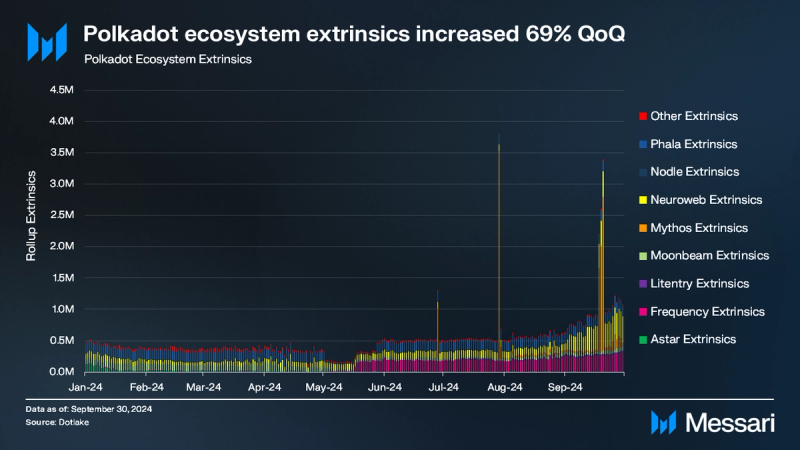
In Q3 2024, Polkadot rollup extrinsics saw a 69% increase compared to Q2, reaching 763,000 daily extrinsics. Despite the decrease in rollup addresses, the increase in extrinsics indicates heightened user activity during Q3 2024.
This growth was primarily driven by several rollups, with Frequency leading the charge. Frequency saw a 133% increase in activity QoQ, reaching 205,000 daily extrinsics. Litentry also experienced a surge in activity, jumping from minimal activity to 20,000 daily extrinsics. Mythos, which recently went live on mainnet, followed closely, reaching 129,000 daily extrinsics due to the popularity of successful games on the network.
Phala Network also recorded significant activity, reaching 147,000 daily extrinsics, marking a 3.6% increase from the previous quarter. Meanwhile, Neuroweb emerged, with 183,000 daily extrinsics. Moonbeam saw a decline in activity, dropping to 37,000 daily extrinsics, while Astar recorded 6,600 daily extrinsics. Finally, Nodle processed 7,800 daily extrinsics.
Financial Analysis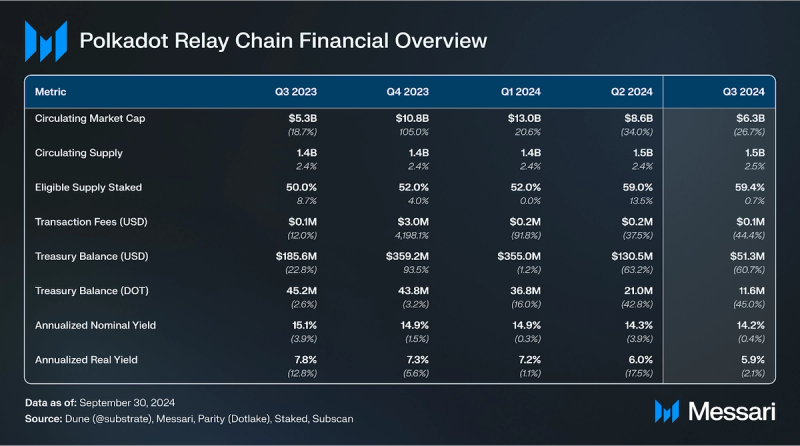 Market Capitalization
Market Capitalization
The last year has seen dramatic swings in the valuation of DOT. Between Q3 2023 and Q1 2024, DOT's market capitalization increased by 150%, rising from $5 billion to $13 billion. However, in Q2 and Q3 2024, DOT retraced along with the broader market, ending Q3 2024 at $6.3 billion (-27% QoQ). DOT's market cap ranking fell one spot, from 14th at the end of Q2 2024 to 15th at the end of Q3 2024. Despite the decline, DOT remained the seventh largest base layer network.
Transaction Fees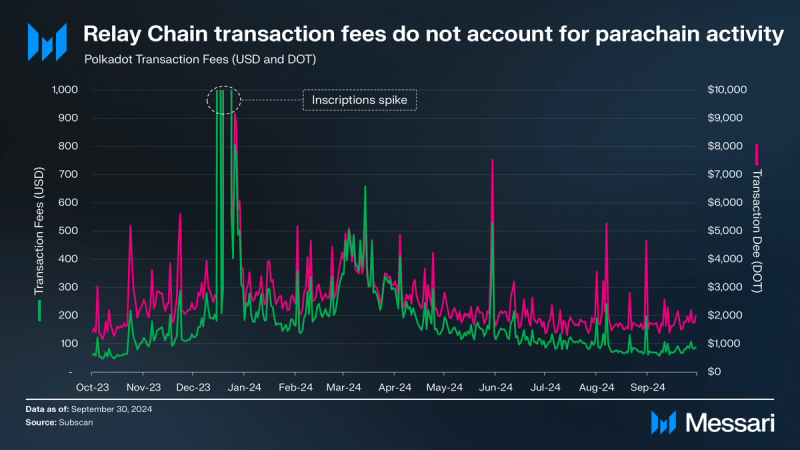
The Polkadot Chain’s total transaction fees tends to be relatively lower compared to its competitors due to the network's structural design. Polkadot experienced an abnormal spike in Q4 2023, with total fees reaching $2.8 million, primarily due to a substantial rise in extrinsics in late December driven by Polkadot Inscriptions.
In Q3 2024, the Polkadot Chain’s transaction fees were in-line with historical averages. Transaction fees were $84,000 (-44% QoQ) and transaction fees denominated in DOT were 17,000 (-21% QoQ).
Treasury
The Polkadot Treasury is financed through block rewards, validator slashing, transaction fees, and staking inefficiencies. Treasury funds held in a system account are allocated for expenditures within a 24-day spend period, with any unspent funds subject to a 1% burn. Notably, all treasury expenditures are executed automatically on-chain. The passage of OpenGov has transformed the referendum lifecycle and decentralized the decision-making process, leading to increased treasury activity.
The Polkadot Treasury continued to see elevated usage in Q3 2024. Specifically, 9.5 million DOT were used for proposals, 7.4 million DOT were used for bounties, and 2.5 million DOT were burned. During Q2 2024, Polkadot Referendum 457 passed, diversifying the Polkadot Treasury with USDT and USDC, allowing treasury proposals to be denominated in stablecoins. The Polkadot Treasury balance at the end of Q3 2024 was $122 million.
SupplyPolkadot’s native token DOT serves three primary purposes: governance, staking, and accessing blockspace. DOT has an inflationary monetary policy and no maximum supply. Its monetary policy adjusts according to network conditions, increasing staking rewards when the staked amount falls below the ideal rate to prevent security compromises, and decreasing rewards when the rate is exceeded to maintain liquidity.
In July 2023, Polkadot introduced a new burning mechanism for revenues from its coretime model, following community consensus. This change directs all coretime revenues to be burned, while maintaining a steady treasury inflow through a guaranteed portion of the inflation rate. Specifically, the treasury now receives at least 20% of annual inflation if the ideal staking rate (60%) is achieved, leading to a decrease in staking rewards from 16.67% to 13.33%. The community also voted for a decrease in inflation to further reduce the maximum inflation rate from 10% to 8% in the first year, then further gradually decreasing, which could bring staking rewards down to 10.67% under similar conditions.
Burning coretime revenues marks the second burning mechanism within Polkadot, alongside the existing practice of burning 1% of treasury funds monthly. While the initial impact of coretime burning will be small due to existing lease commitments expiring in 2026, it is expected to gradually grow over time.
As of Q3 2024, Polkadot’s supply metrics included a circulating supply of 1.5 billion (+2.5% QoQ) and a staked supply of 891 million DOT, resulting in 59.4% of the eligible supply being staked (+0.7% QoQ). The yields were an annual nominal yield of 14.2% (-0.4% QoQ) and an annual real yield of 5.9% (-2.1% QoQ).
Network Analysis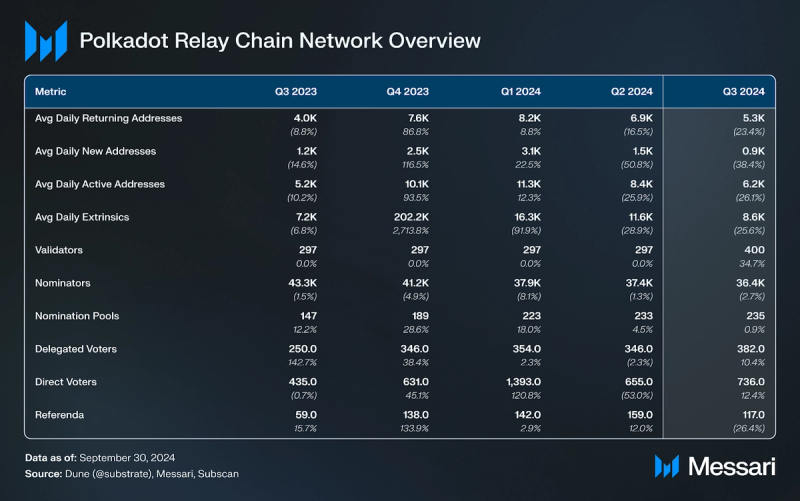 Usage
Usage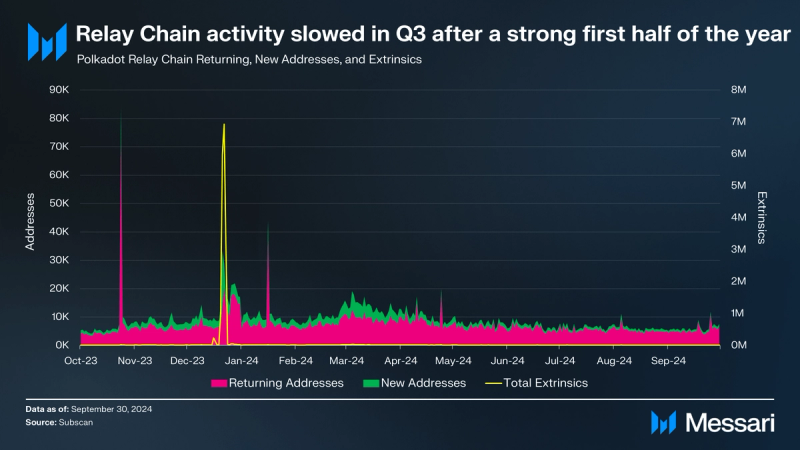
The Polkadot Chain (aka Relay Chain) has several primary functions, including securing and connecting rollups. Consequently, end users typically transact and use the network primarily through the rollups. The Polkadot Chain does support some end-user functionalities, including token transfers, staking, validator elections, governance voting, and participation in rollup slot auctions. With RFC-0032: Minimal Relay, it is proposed to migrate several of these subsystems into system rollups.
Polkadot Chain activity continued to decline in Q3 2024. Daily active addresses dropped to 6,200 (-26% QoQ), daily returning addresses fell to 5,300 (-23% QoQ), and daily new addresses decreased to 900 (-38% QoQ).
In the Polkadot network, an extrinsic is an element that facilitates state transitions within the Polkadot Chain, akin to a transaction on other networks. From December 20th to 23rd, Polkadot Chain extrinsics surged due to Polkadot Inscriptions, with the Polkadot Chain processing 4.3 million daily extrinsics. The network successfully managed this influx without any performance decline. Average daily extrinsics in Q3 2024 were 8,600 (-26% QoQ).
Security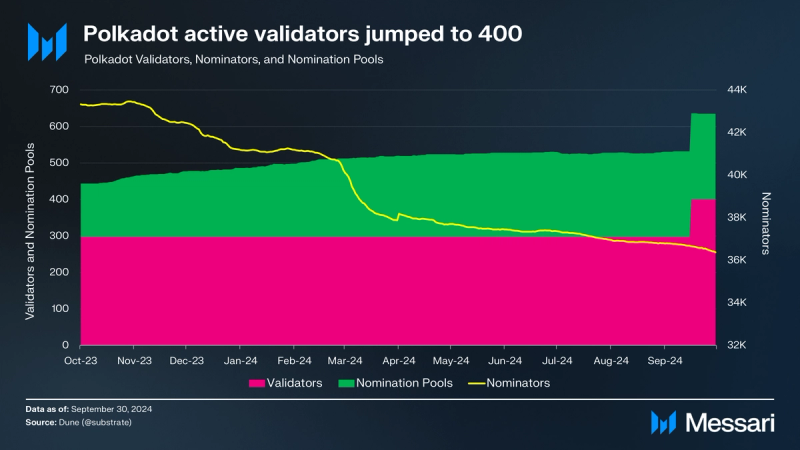
Polkadot uses a Nominated Proof-of-Stake (NPoS) model designed to decentralize the validator set. Validators receive payments every 24 hours based on their completion of payable actions known as era points. This model incentivizes nominators to stake with lower-staked validators to earn higher rewards, resulting in a consistently decentralized validator set. The number of active validators increased to 400. Referendum 888 seeks to enable two approval voting protocol improvements, which are prerequisites to scaling the number of Polkadot validators to 500.
The Web3 Foundation launched the Decentralized Nodes Program in October 2024 to support validators. Validators can apply for up to two nodes per network, selected based on technical expertise, reliability, and ecosystem engagement. Selected participants will serve a four-month term starting in November 2024, with potential renewal.
As of Q3 2024, there were 36,400 nominators (-3% QoQ). Nomination Pools, which allow users to pool their DOT tokens together on-chain to nominate validators and receive rewards, numbered 235 at the end of Q3 2024 (+1% QoQ).
Governance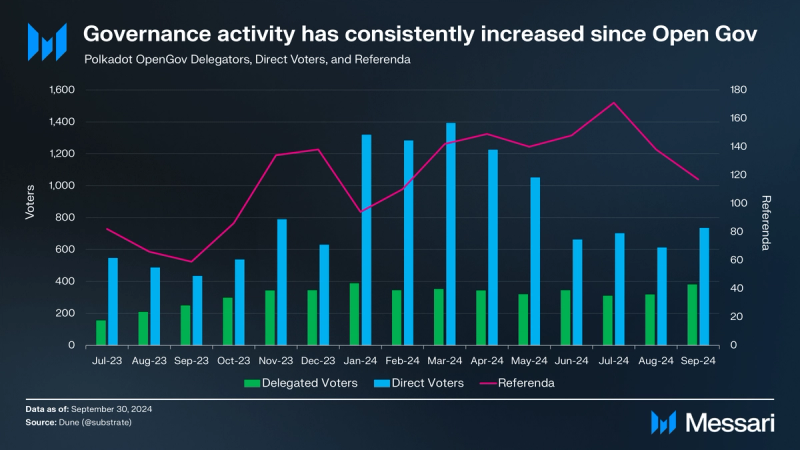
OpenGov, the new governance model for Polkadot, has transformed the referendum lifecycle and decentralized the decision-making process. The system allows multiple referenda to run concurrently, enabling faster decision-making. The Council and Technical Committee have been replaced by the Fellowship, a developer DAO that ensures decentralization through community voting, checks and balances, and flexible delegation based on conviction and token commitment.
Governance activity continued to increase in Q3 2024. As of Q3 2024, there was a monthly average of 382 delegated voters (+10% QoQ) and 736 direct voters (+12% QoQ). The number of referenda was 117.
Additionally, in Q2 2024, Polkadot DAO allocated 3 million DOT to enhance DeFi, with 2 million DOT for Hydration to improve liquidity and trading efficiency, and 1 million DOT for StellaSwap to optimize AMM efficiency. Polkadot also chose race car driver Conor Daly as its brand ambassador and became the Global Training Partner for Inter Miami CF through community governance.
Technical RoadmapPolkadot completed Polkadot 1.0 in 2023, fulfilling the objectives outlined in the Polkadot whitepaper. Polkadot 2.0, shaped by community discussions and consensus, builds on this foundation. The leasing model of Polkadot 1.0, which required competitive auctions and significant DOT collateral for rollups, posed barriers to smaller projects and often resulted in suboptimal resource utilization.
Polkadot 2.0 introduces a dynamic economic model to manage computational resources through several key technical upgrades, including:
- Agile Coretime: Released during Q3 2024, Agile Coretime enhances the network’s scalability, cost-efficiency, speed, and flexibility by dynamically allocating computational resources. This feature replaces the previous system of leasing single cores through auctions with an on-demand blockspace model, adjusting resource availability based on network demand. This approach helps prevent resource wastage during periods of low activity and mitigates congestion during peak times.
- Elastic Scaling: This upgrade, the only component of Polkadot 2.0 not yet live, enables rollups to utilize multiple cores within the same Relay Chain block, increasing network throughput and efficiently handling higher transaction loads.
- Asynchronous Backing: Released during Q2 2024, Async Backing optimizes block generation and validation by enhancing the efficiency and throughput of parablocks. This upgrade reduces block time from twelve to six seconds, delivering up to 10x higher throughput for Polkadot’s rollup consensus protocol.
These advancements, aim to improve transaction speed, scalability, and developer accessibility, while lowering barriers for decentralized applications and enhancing the network's flexibility. Additionally, Polkadot 2.0’s rebranding effort focuses on user-friendliness and community-driven growth, fostering a more decentralized and accessible ecosystem.
For a deep dive on Polkadot 2.0, check out our report Polkadot 2.0 Rebirth: An Overview.
Closing SummaryIn Q3 2024, the Polkadot ecosystem made substantial progress on Polkadot 2.0, focusing on enhancing core functionalities to improve transaction speed, scalability, and accessibility for developers. With the introduction of Agile Coretime, Polkadot moved to an adaptive block space model that efficiently adjusts to network demand, reducing resource wastage during low-traffic periods and alleviating congestion when activity surges.
Polkadot also experienced heightened traction across its network, as evidenced by a 69% increase in daily rollup extrinsics, averaging 763,000 for the quarter. This growth was largely driven by rollups like Frequency, Litentry, and NeuroWeb (the new name for the OriginTrail parachain), which saw notable increases in user engagement, contributing significantly to the overall network activity and demonstrating the platform's scalability and flexibility.
- Home
- About Us
- Write For Us / Submit Content
- Advertising And Affiliates
- Feeds And Syndication
- Contact Us
- Login
- Privacy
All Rights Reserved. Copyright , Central Coast Communications, Inc.